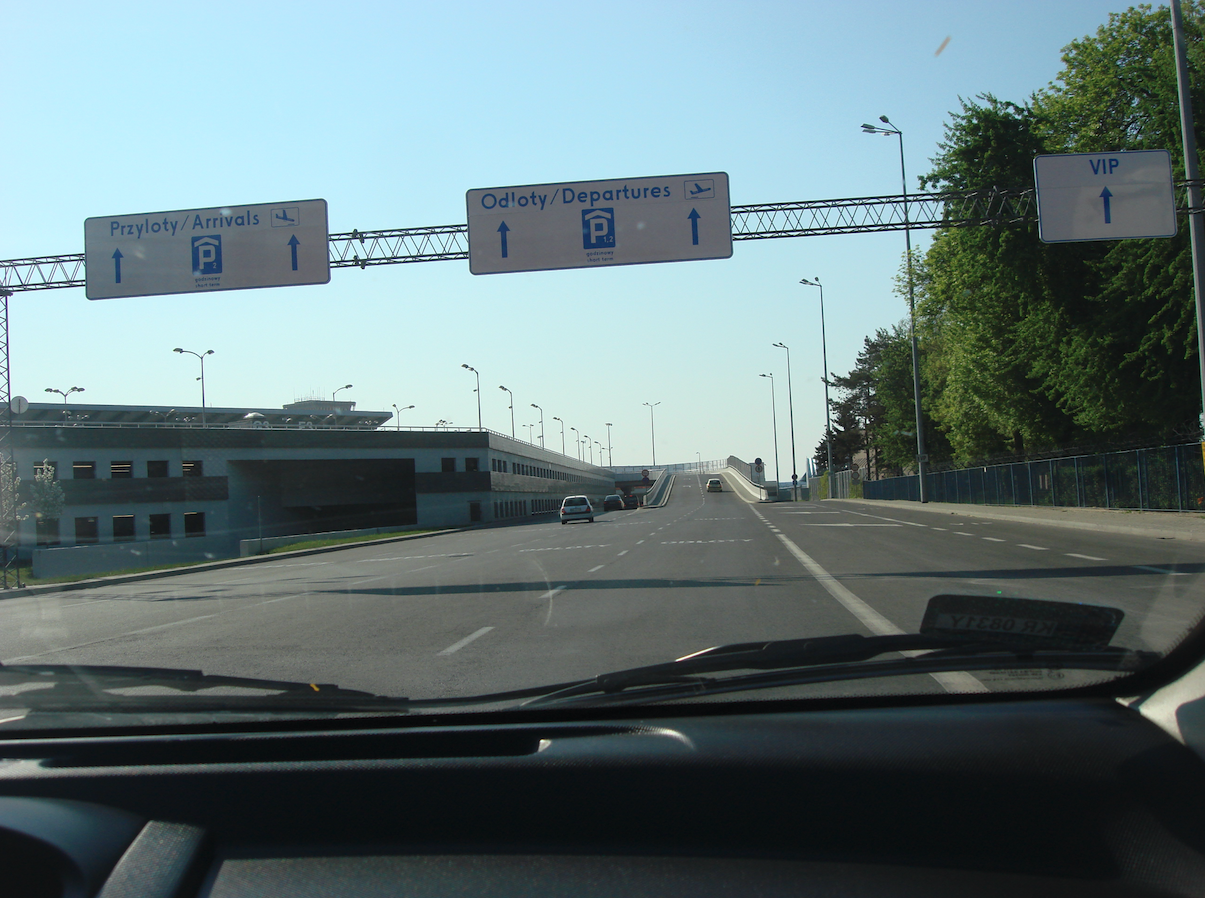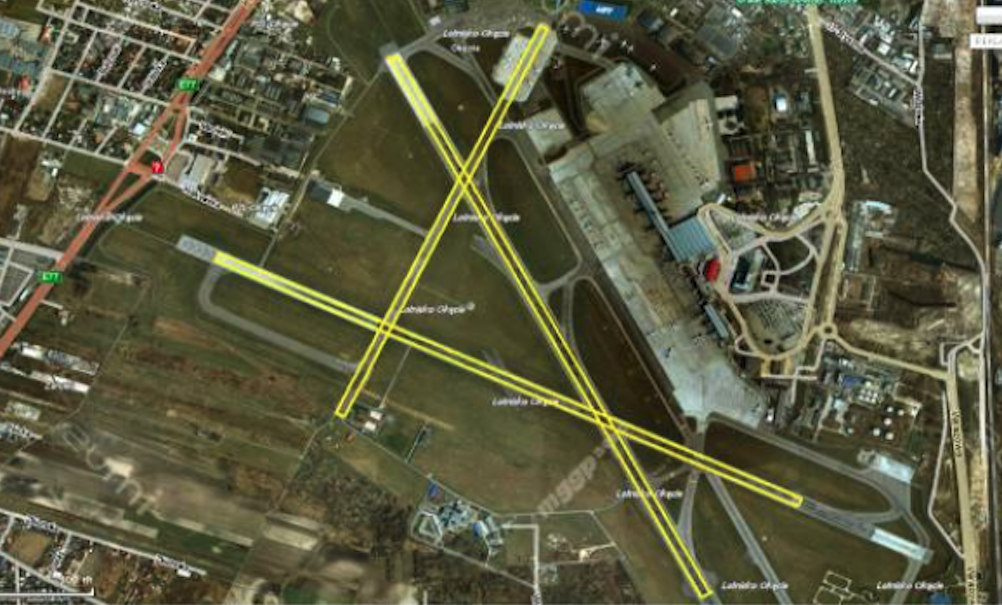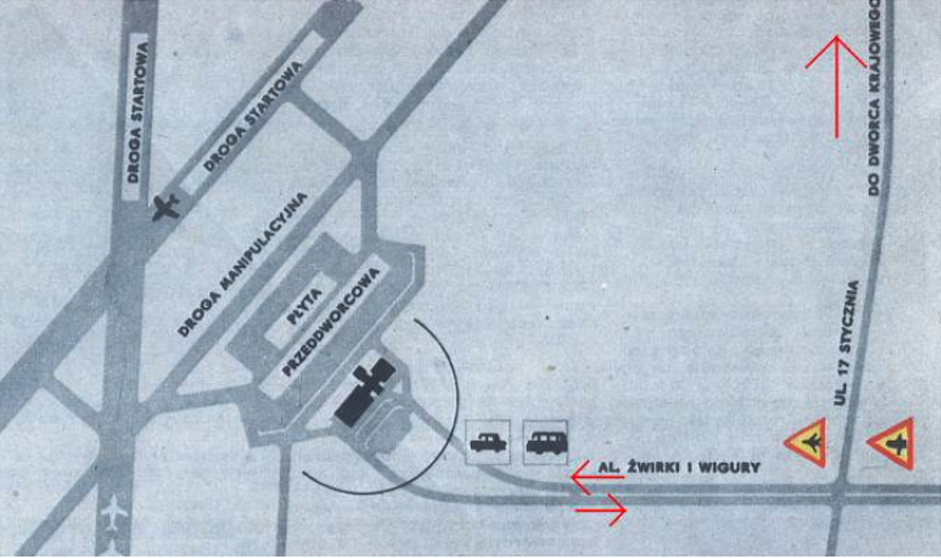Kraków 2010-02-01
Airport Okęcie.
Okęcie airport from 1945 to 1990.

A few sentences about RWY (DS.) at Okęcie Airport.
When Okęcie Airport was opened in 1934, there were no paved runways. The take-off field was built in the shape of an ellipse, according to the French models of the time. The taxiing areas consisted of two parts. The first is a concrete platform slab. It was situated in front of the station buildings and the adjacent hangars. All aircraft and passenger service was carried out on it. Already at that time, passengers' luggage was delivered to the plane by the airport service on handcarts. Beyond the plate was the landing field. The landing area of the airport was 1,270 m along the north-south axis and 1,470 m along the east-west axis. It had a ground surface with systematically mowed grass. The weight of the planes was not so great that additional hardening of the landing field was necessary. In those days, airplanes took off and landed directly against the wind. Therefore, the plane preparing to take off was taxiing to the edge of the take-off field on the leeward side. There he would face the wind and take off. This was the global standard at the time.

Three paved runways were built. Unfortunately, it soon turned out that DS. (RWY) in direction 03/21 cannot be used. On its extension, a mast was built in Raszyn on one side, and the Palace of Culture and Science in the center of Warsaw on the other. So the airport remained with two DS. (RWY), which in the following years were lengthened, widened and their carrying capacity increased. DS (RWY) in direction 03/21 to this day serves as DK.
Okęcie Airport in the times of the People's Republic of Poland.
After World War II, Okęcie was rebuilt in a small percentage for many years, and passenger check-in took place in makeshift buildings located at 17 Stycznia Street. Virtually no photos from this period have survived. It's no wonder. In the People's Republic of Poland, anyone with a camera, e.g. a friend, was a potential spy. The safest photos were taken in the ID card atelier and in the zoo.
What was the reason? We can write briefly - communist rule. But that's a shortcut. Firstly. Passenger flights were considered an imperialist convenience in the East. Secondly. The Russians decided to build a large military airport in Bemowo. It was at that airport that planes with delegations from abroad landed. It was there that the Soviet "miracles of technology" were demonstrated, such as the Tupolev Tu-104 plane, which had to use braking parachutes to land at the Bemowo Airport.
Passengers were transported by truck, because the production of buses had not yet started. Behind the fence are two Spitfire fighters, which the pilots of the 302 and 317 Squadrons returned from England to the country. After a few years, these planes were cut up and destroyed with axes. Okęcie airport in 1946.
The first post-war airport was more than spartan. It was located in the northern part of the airport at 17 Stycznia Street. After opening in 1969, the MDL (International Airport) began to perform only the functions of the National Railway Station. All those departing to Polish cities used this station for many decades, until the end of the 80s.
In May 1951, the city of Włochy and the commune of Okęcie were incorporated into the city of Warsaw. They became a part of the Warszawa-Ochota District, which was then separated as an independent administrative and economic unit.
In 1994, as a result of the new administrative division of the city, Okęcie became a part of the Warsaw-Włochy commune. Changes in both the administrative affiliation and the incorporation of Okęcie into the city of Warsaw had a significant impact on the economic and educational development in this area, caused by the increase in the number of inhabitants.
The airport from 1969.
Preparations were made for the construction of a new air station almost from 1945, but it always took a while. At the end of the 1950s, further analyzes were carried out and the need to build a new station turned out to be absolutely necessary. This analysis was used by the Main Board of the Association of Polish Architects and in 1960, a competition was organized for the design of the International Airport (MDL). The winner of the competition was the design of Krystyna and Jan Dobrowolski, Master of Engineers. It turned out to be necessary not only to build the MDL, but also to expand all the facilities of the Warsaw-Okęcie Central Airport. Slowly, the authorities became aware of the information that Okęcie Airport was to be a showcase of Poland, of Socialist Poland. "Where people live well."
After long months, the Party gave the green light and the Warsaw Office of Studies and Designs of Road and Air Transport started to prepare a technical project. The head of the technical team was Dariusz Rogowski, M.Sc. Engineer. They designed the structure of the building; Aleksander Włodarz, Czeslaw Cywiński, Witold Jędrzejewski and Tadeusz Tesarski. They worked hard for such an unusual building.
It was not until 1964 that the construction of the MDL began. A real train station. Just like the one from 1934, of course on a new scale. At the end of the reign of the inept Władysław Gomułka, after five years of construction, on April 27, 1969, a new airport was opened along with the flight control tower, called the mushroom, and the famous observation deck.

The station itself was spacious and I liked it. The ceiling aroused special admiration; spatial, prismatic, as if crystal. He perfectly complemented the whole and it is no wonder that he was featured in almost all the photos. It looked great inside as well as in aerial photos. It is a pity that there were defects in the roof and it was leaking locally. The object was so liked by party colleagues that they decided to distinguish it with a state award. Also noticed with appreciation, due to its architecture and construction, by representatives of foreign airlines and foreign passengers arriving in Poland.
The observation deck was an extremely simple but very attractive structure. Its total length was 230 m. It was from it that departing relatives and friends were greeted and departed from. It was also a place for family and school trips, not only for Varsovians. This terrace has become the scene of many scenes in Polish Films.
The modern facility was the control tower. Not as tall as the one from 1934, but it did its job perfectly. From it, the movement of planes on the platform apron was handled. Under the tower was the so-called pilot's cottage. In the 70s, Okęcie Airport looked good. With the opening of the new station, bus line No. 175 was launched, which runs to this day (2009).
The station was used until 1992, when a new station, called Terminal 1, was opened. Further spatial management of the investor led to the creation of foreign pavilions, such as Finnish and later German. As a result, the station from 1969 was demolished in 1998.
Written by Karol Placha Hetman
